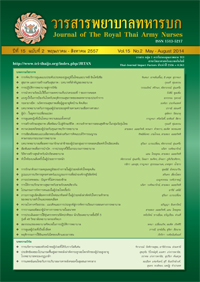การเปรียบเทียบผลการสวดมนต์และการฟังเสียงสวดมนต์ต่อความเครียดและคุณภาพการนอนหลับของผู้ป่วยมะเร็งเต้านม Comparison Between Praying and Listening to the Pray on Stress and Quality of Sleep in Breast Cancer Patients
Keywords:
มะเร็งเต้านม, คุณภาพการนอนหลับ, สวดมนต์, Breast cancer, Quality of sleep, StressAbstract
การศึกษาเป็นการวิจัยกึ่งทดลอง มีวัตถุประสงค์เพื่อเปรียบเทียบผลของการสวดมนต์และการฟังเสียงสวดมนต์ต่อความเครียดและคุณภาพการนอนหลับของผู้ป่วยมะเร็งเต้านม กลุ่มตัวอย่าง คือผู้ป่วยมะเร็งเต้านมที่พัก ณ บ้านพักฉุกเฉิน แบ่งแบบสุ่มเป็นกลุ่มสวดมนต์และกลุ่มฟังเสียงสวดมนต์ กลุ่มละ 22 คน ใช้เวลาในการวิจัย 4 สัปดาห์ เครื่องมือที่ใช้ได้แก่ แบบวัดความเครียดสวนปรุง และแบบวัดคุณภาพการนอนหลับของเวอร์แรนและสไนเดอร์ ฮาล์เพิร์น ซึ่งมีค่าสัมประสิทธิ์อัลฟาของครอนบาค 0.84 และ 0.80 ตามลำดับ วิเคราะห์ข้อมูลด้วยการทดสอบสถิติที่เป็นอิสระจากกัน และเป็นไม่อิสระจากกัน โดยกำหนดนัยสำคัญทางสถิติที่ระดับ < .05 ผลการวิจัยพบว่า 1. ค่าเฉลี่ยความเครียดของผู้ป่วยมะเร็งเต้านมกลุ่มสวดมนต์ลดลงหลังการสวดมนต์ (t = 13.73, p < .05) 2. ค่าเฉลี่ยความเครียดของผู้ป่วยมะเร็งเต้านมกลุ่มฟังเสียงสวดมนต์ลดลงอย่างมีนัยสำคัญทางสถิติ (t = 5.59, p < .05) 3. ค่าเฉลี่ยความเครียดของผู้ป่วยมะเร็งเต้านมกลุ่มสวดมนต์ต่ำกว่ากลุ่มฟังเสียงสวดมนต์ (t = 3.13, p < .05) 4. ค่าเฉลี่ยคุณภาพการนอนหลับของผู้ป่วยมะเร็งเต้านมกลุ่มสวดมนต์สูงขึ้นอย่างมีนัยสำคัญทางสถิติ (t = 22.54, p <. 05) 5. ค่าเฉลี่ยคุณภาพการนอนหลับของผู้ป่วยมะเร็งเต้านมกลุ่มฟังเสียงสวดมนต์สูงขึ้นอย่างมีนัยสำคัญทางสถิติ (t = 11.82, p < .05) 6. ค่าเฉลี่ยคุณภาพการนอนหลับของผู้ป่วยมะเร็งเต้านมกลุ่มสวดมนต์และกลุ่มฟังเสียงสวดมนต์ไม่แตกต่างกัน (t = .28, p = .780) ผลการศึกษาเป็นหลักฐานว่าทั้งการสวดมนต์และการฟังเสียงสวดมนต์ลดความเครียดและเพิ่มคุณภาพการนอนหลับ คณะผู้วิจัยเสนอแนะว่าในการดูแลผู้ป่วยมะเร็งเต้านม พยาบาลควรจัดกิจกรรมการสวดมนต์หรือเปิดเสียงสวดมนต์ให้ฟังเพื่อช่วยลดความเครียดและส่งเสริมการนอนหลับให้แก่ผู้ป่วย
This quasi- experimental research aimed to compare between praying and listening of the pray on stress and quality of sleep in breast cancer patients. Forty-four patients with breast cancer at emergency shelters were randomly divided equal into a praying group and a listening of the pray group. Each was asked to pray or listen to the pray every day for 4 weeks continuously. The data were obtained through 2 questionnaires: Suanprung Stress Test and Verran and Snyder-Halpern Sleep Scale. The cronbach’s alpha coefficient of the questionnaires were 0.84, and 0.80 respectively. The data were analysed using independent and paired t-test. The significant difference was set at p< .05. The results illustrated that 1. Stress scores of the praying group at posttest were significantly lower than that of pretest (t = 13.73, p<.05). 2. Stress scores of the listening of the pray group at posttest were significantly lower than that of pretest (t = 5.59, p<.05). 3. Stress scores of the praying group were significantly lower than the listening of the pray group (t = 3.13, p<.05). 4. Mean scores of quality of sleep of the praying group at posttest were significantly higher than that of pretest (t = 22.54, p<.05). 5. Mean scores of quality of sleep of the listening of the pray group at posttest were significantly lower than that of pretest (t = 11.82, p<.05). 6. There were no statistically significant difference on the quality of sleep between both groups (t = .28, p = .780). It was an evidence that both praying and listening of the pray help to reduce stress and increase quality of sleep. The researchers recommended using both praying and listening of the pray as nursing intervention for breast cancer patient.
Downloads
Downloads
How to Cite
Issue
Section
License
บทความหรือข้อคิดเห็นใดใดที่ปรากฏในวารสารพยาบาลทหารบกเป็นวรรณกรรมของผู้เขียน ซึ่งบรรณาธิการหรือสมาคมพยาบาลทหารบก ไม่จำเป็นต้องเห็นด้วย
บทความที่ได้รับการตีพิมพ์เป็นลิขสิทธิ์ของวารสารพยาบาลทหารบก
The ideas and opinions expressed in the Journal of The Royal Thai Army Nurses are those of the authors and not necessarily those
of the editor or Royal Thai Army Nurses Association.






